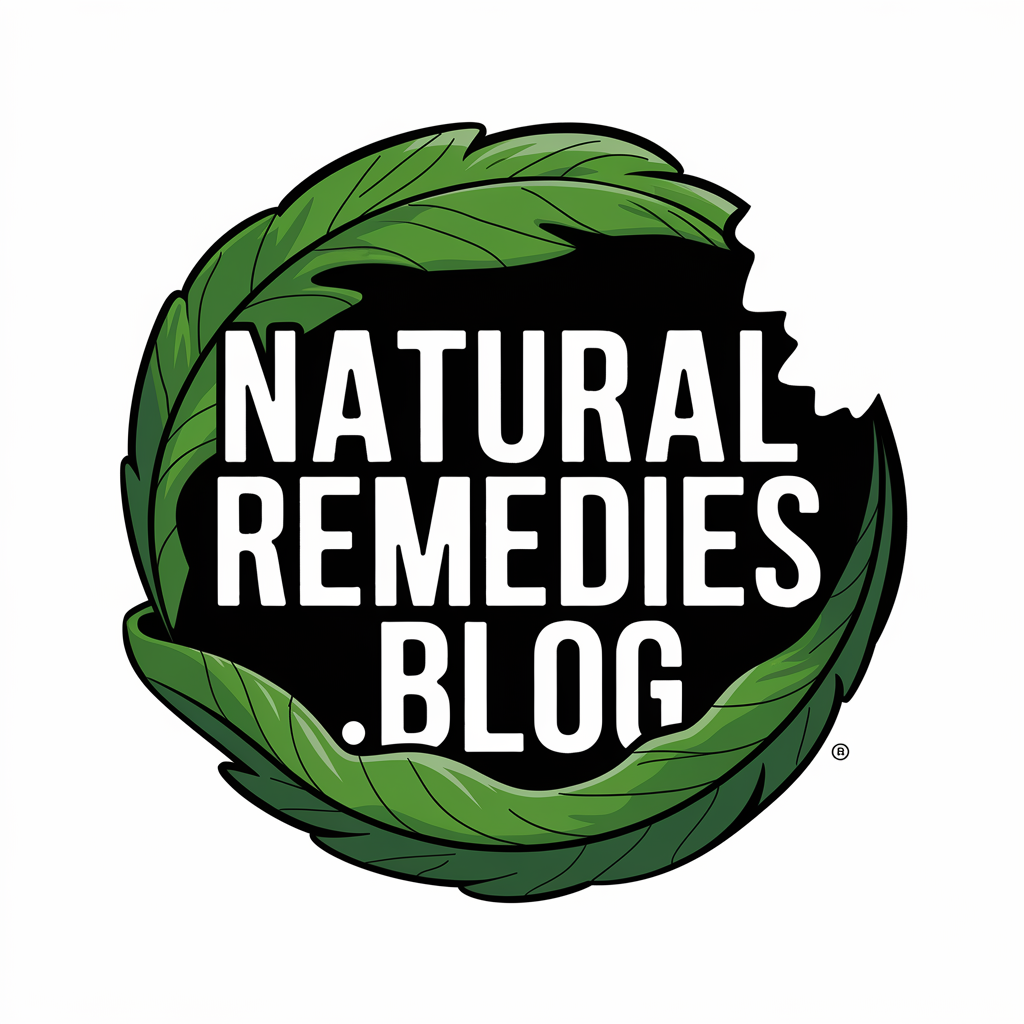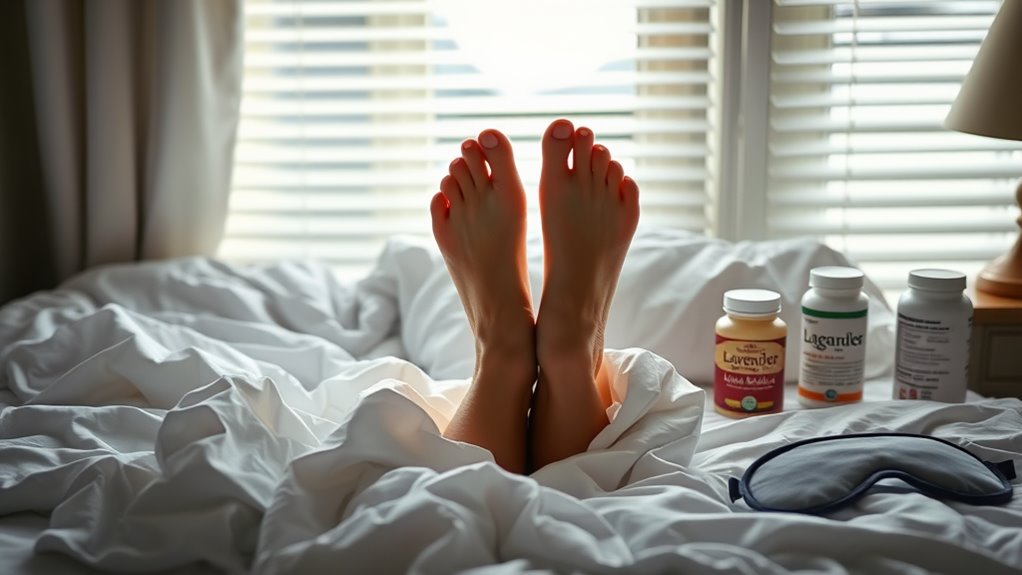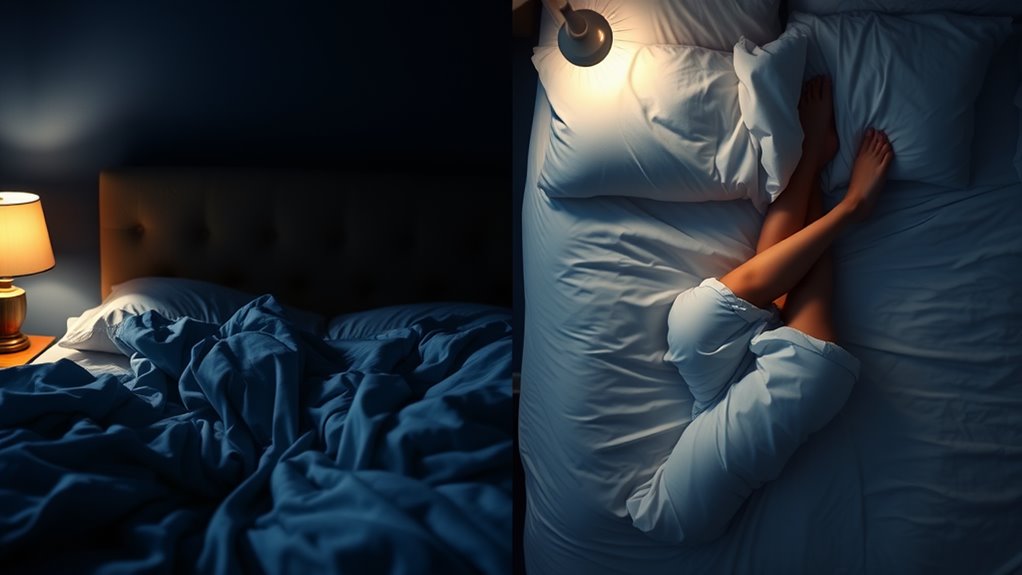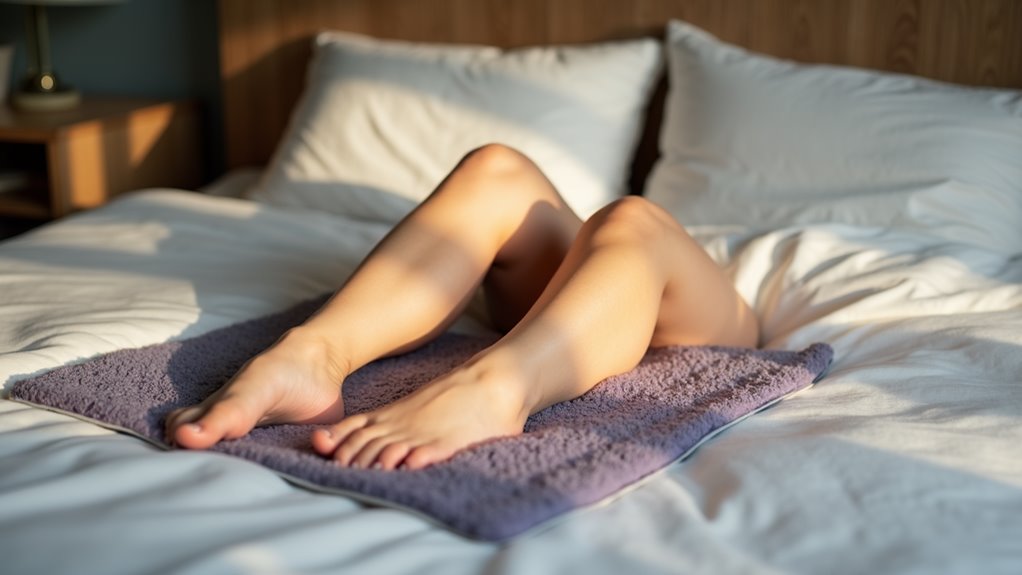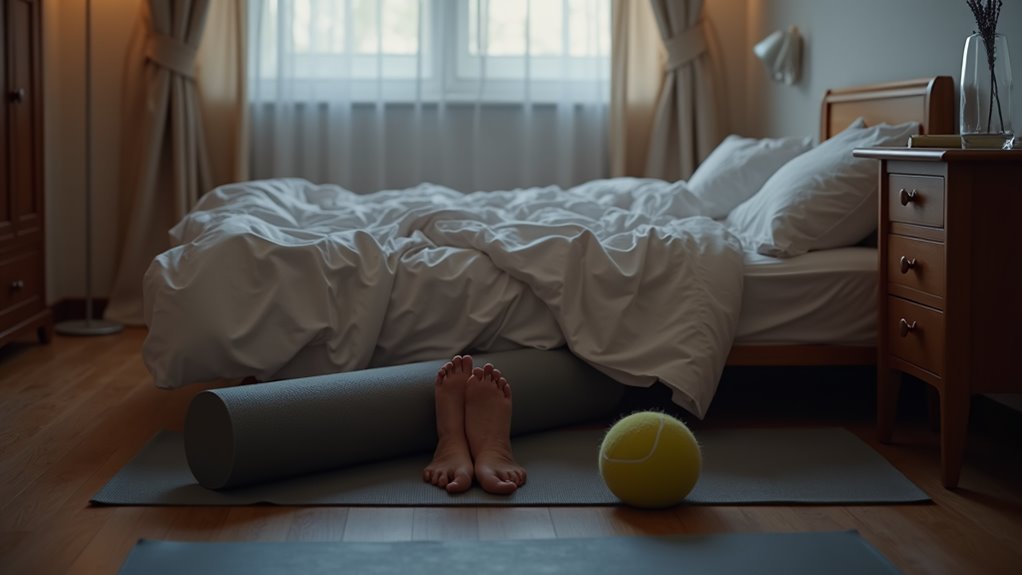Can’t Sleep Due to Restless Legs. This Might Help
If you can’t sleep due to restless legs, try gentle stretching exercises before bed and keep your bedroom cool at 60-67°F (15-19°C). Avoid caffeine, alcohol, and vigorous exercise close to bedtime. Apply alternating hot and cold therapy for 20 minutes to relax muscles and improve circulation. Consider taking iron supplements if your ferritin levels are low. For more severe cases, your doctor can recommend specific medications and treatments to help manage your symptoms effectively.
Key Takeaways
-
Keep your bedroom cool (60-67°F), dark, and quiet, using breathable bedding to prevent overheating during sleep.
-
Practice gentle leg stretches before bed and use compression stockings during the day to minimize nighttime symptoms.
-
Avoid vigorous exercise close to bedtime, and schedule workouts for morning or afternoon to prevent symptom flare-ups.
-
Apply alternating hot and cold therapy for 20 minutes to reduce muscle tension and improve circulation before sleep.
-
Establish consistent sleep times and create a relaxing bedtime routine without caffeine or alcohol consumption.
Understanding Restless Legs Syndrome and Sleep Disruption
How does a seemingly simple urge to move your legs transform into a significant sleep disorder?
When you have Restless Legs Syndrome (RLS), your brain’s dopamine system malfunctions, creating unpleasant sensations that compel you to move your legs for temporary relief. These symptoms intensify during periods of inactivity, particularly at night when you’re trying to sleep.
As you lie in bed, the creeping, tingling, or pulling sensations in your legs can make it impossible to fall asleep or stay asleep through the night. This disruption is further exacerbated by reduced physical activity, which can lead to worsening symptoms and increased difficulty in managing RLS.
This sleep disruption creates a vicious cycle – poor sleep worsens RLS symptoms, and worsening symptoms further deteriorate your sleep quality. While various restless leg remedies exist, understanding this neurological connection helps explain why simple movement provides momentary relief but doesn’t address the underlying condition.
For those with a family history, RLS often develops before age 40 and can be traced to specific chromosomal locations.
Natural Ways to Calm Restless Legs at Night
You’ll find relief from restless legs through moderate exercise like walking or stretching before bedtime, which helps reduce nighttime symptoms and promotes better sleep. Engaging in gentle leg stretches can specifically target areas that often contribute to discomfort. Alternating between warm baths or heating pads and cold packs can effectively soothe uncomfortable leg sensations, as thermal therapy improves circulation and muscle relaxation. Reducing your caffeine intake throughout the day can significantly minimize symptoms when it’s time to rest.
Your sleep environment should be cool, dark, and quiet, with comfortable bedding that supports proper leg positioning to minimize nighttime movements.
Exercise Before Bedtime Works
Contrary to popular advice, exercising before bedtime can actually worsen Restless Legs Syndrome (RLS) symptoms rather than alleviate them. Vigorous nighttime exercise increases muscle heat and inflammation, potentially intensifying your RLS discomfort.
Instead, you’ll find better symptom management by exercising earlier in the day.
Schedule your workouts for morning or afternoon hours, focusing on low-impact activities for 30-60 minutes.
This timing allows your body to properly cool down and regulate before sleep.
If you need immediate relief at night, try gentle seated exercises or simple leg stretches while lying down. Simple stretching can provide instant relief from RLS symptoms.
You can also enhance your routine’s effectiveness by wearing compression stockings during daytime workouts and maintaining proper hydration.
Remember to keep your exercise intensity moderate, as strenuous workouts may trigger symptom flare-ups.
Hot-Cold Therapy Benefits
A powerful natural approach for managing Restless Legs Syndrome involves alternating hot and cold therapy, which targets multiple symptom pathways simultaneously. You’ll find relief through 20-minute applications at temperatures between 38.5°C-41.5°C for heat therapy, while cold treatments focus on reducing localized inflammation. Studies show this method effectively reduces muscle tension, improves circulation, and modulates pain signals. The approach has proven especially beneficial for pregnant women, showing superior outcomes in clinical studies.
| Therapy Type | Benefits | Best Times |
|---|---|---|
| Heat | Muscle relaxation, blood flow | Before bed |
| Cold | Inflammation reduction, pain relief | During flare-ups |
| Alternating | Enhanced overall effects | 8-session course |
| Bath-based | Full-body treatment | Evening routine |
This cost-effective treatment works particularly well for those seeking drug-free options and has shown significant benefits for dialysis patients and those with secondary RLS. You’ll get optimal results by incorporating it into your nightly routine.
Create Better Sleep Environment
Creating an optimal sleep environment plays a crucial role in managing Restless Legs Syndrome (RLS) and improving overall sleep quality.
Your bedroom should promote relaxation and minimize disruptions that could trigger or worsen RLS symptoms. Dim lighting and calming music before bedtime can create a more restful atmosphere for sleep.
Focus on maintaining a consistently cool temperature, ensuring complete darkness, and reducing noise levels with white noise machines or earplugs if needed.
- Keep your bedroom clutter-free and organized to reduce psychological stress, as mental tension can exacerbate RLS symptoms
- Install blackout curtains or use an eye mask to block out light, helping your body recognize it’s time for sleep
- Set your thermostat between 60-67°F (15-19°C) and use comfortable, breathable bedding to prevent overheating, which can intensify restlessness
Medical Treatment Options Worth Discussing With Your Doctor
Medical treatments for Restless Legs Syndrome (RLS) range from dopaminergic medications to iron supplementation, with options carefully selected based on symptom severity and individual patient factors.
Your doctor might prescribe calcium channel alpha-2-delta ligands like gabapentin or pregabalin as first-line treatments, as they don’t carry the augmentation risks associated with dopaminergic drugs.
If you have low ferritin levels (≤75 μg/L), iron supplementation with ferrous sulfate plus vitamin C could significantly improve your symptoms.
For moderate to severe RLS, medications like pramipexole or ropinirole may be recommended, though they require monitoring for side effects and symptom changes.
In treatment-resistant cases, your doctor might consider opioids or benzodiazepines, but these are typically reserved as last-resort options due to dependency risks. Additionally, it is essential to understand that RLS symptoms often worsen in the evening and at night, impacting sleep quality.
Lifestyle Changes That Make a Real Difference
Simple lifestyle modifications can dramatically improve your Restless Legs Syndrome symptoms without requiring medication.
Start by creating an optimal sleep environment that’s cool, quiet, and free from electronic distractions.
Incorporate regular, moderate exercise during the day, but avoid vigorous activities close to bedtime.
Pay attention to your diet by consuming iron-rich foods and staying hydrated while limiting caffeine and processed foods.
- Practice stress-reduction techniques like meditation, yoga, or warm evening baths to calm your nervous system, as regular physical exercise can also significantly reduce RLS symptoms.
- Establish a consistent sleep schedule and create a relaxing bedtime routine that includes gentle leg massage.
- Engage in mindful activities that distract you from symptoms while maintaining a support network of understanding friends and family.
Creating the Perfect Bedtime Routine for RLS Management
A well-structured bedtime routine serves as the cornerstone of effective Restless Legs Syndrome management.
You’ll need to establish consistent sleep and wake times while creating an environment that promotes rest.
Keep your bedroom cool, quiet, and free from electronic distractions.
Begin winding down two hours before bed with gentle stretches and relaxation techniques.
Practice mindful breathing or progressive muscle relaxation to calm your nervous system.
Take a warm bath, but finish it early enough to allow your body temperature to regulate.
If you’re using supplements, time them according to your healthcare provider’s guidance.
Don’t overlook your bedding comfort – invest in quality pillows and mattress materials that support proper sleep posture.
Document your routine’s effectiveness in a sleep diary to identify what works best for you. Additionally, incorporating targeted muscle stretches before bedtime can significantly alleviate discomfort and enhance your overall sleep experience.
When to Seek Professional Help for RLS
While developing a bedtime routine helps many people with RLS, recognizing when to seek professional medical help marks an important step in managing this condition.
You should consult a healthcare provider when your symptoms begin to significantly impact your quality of life or when lifestyle changes aren’t providing adequate relief.
- If you’re experiencing an irresistible urge to move your legs accompanied by uncomfortable sensations, particularly during rest or at night, that interfere with sleep
- When symptoms persist or worsen despite trying over-the-counter remedies and lifestyle modifications
- If you notice new neurological symptoms, sudden onset of severe symptoms, or develop complications like anxiety or depression related to RLS
Your doctor may refer you to specialists like neurologists or sleep medicine experts who can provide targeted treatment options, including medication when necessary. Gentle exercises may also be recommended by your healthcare provider to help alleviate symptoms.
References
- https://www.ninds.nih.gov/health-information/disorders/restless-legs-syndrome
- https://my.clevelandclinic.org/health/diseases/9497-restless-legs-syndrome
- https://www.mayoclinic.org/diseases-conditions/restless-legs-syndrome/symptoms-causes/syc-20377168
- https://www.nm.org/healthbeat/healthy-tips/is-restless-legs-syndrome-ruining-your-sleep
- https://guysandstthomasspecialistcare.co.uk/news/restless-legs-syndrome-and-chronic-sleep-disturbances/
- https://www.nhs.uk/conditions/restless-legs-syndrome/causes/
- https://www.hopkinsmedicine.org/health/conditions-and-diseases/restless-legs-syndrome-rls
- https://www.mayoclinic.org/diseases-conditions/restless-legs-syndrome/diagnosis-treatment/drc-20377174
- https://www.webmd.com/brain/restless-legs-syndrome/ss/slideshow-rls-remedies
- https://www.healthline.com/health/restless-leg-syndrome
